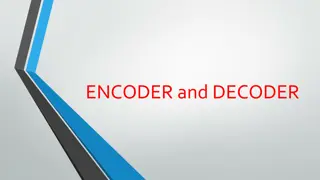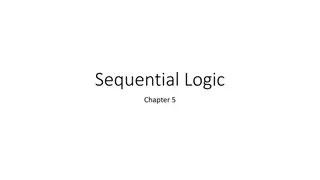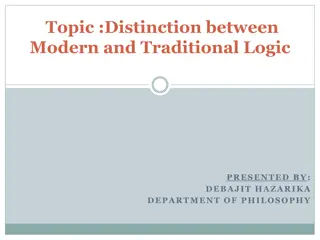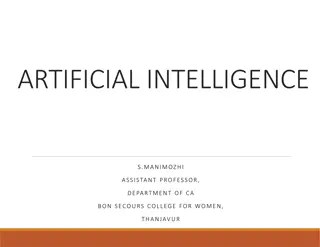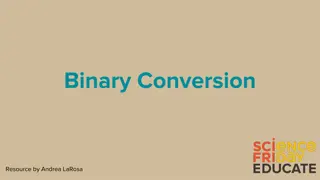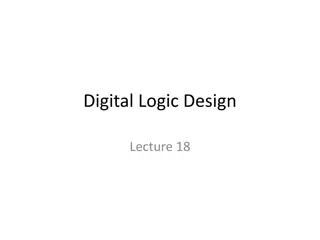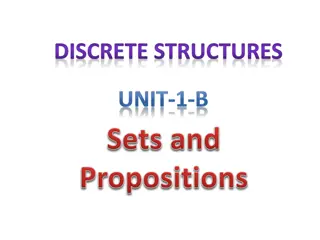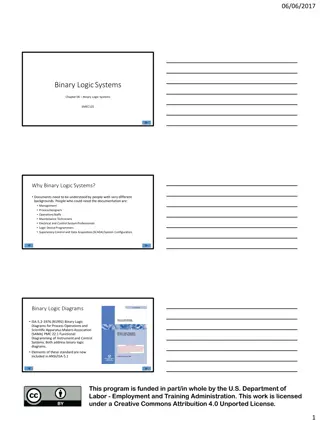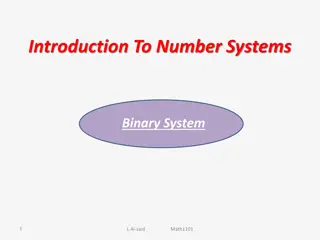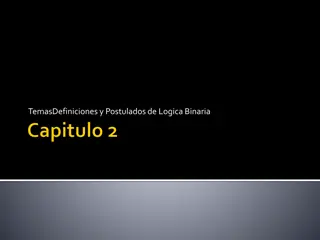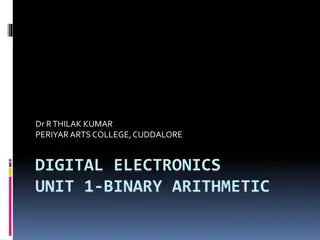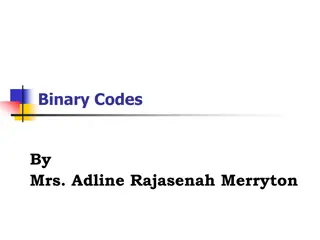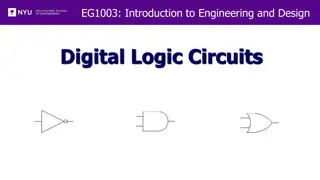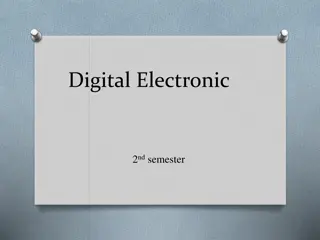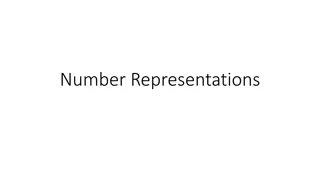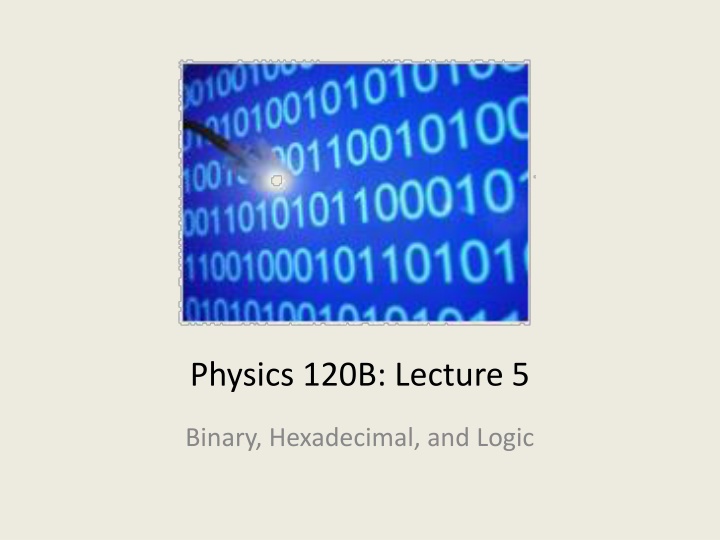
Binary, Hexadecimal, and Logic in Physics 120B
Explore the concepts of binary, hexadecimal, and logic in Physics 120B lectures, including conversion tables, ASCII codes, and logic families such as TTL and CMOS. Learn about transistors and their modes of operation like amplifiers and switches.
Download Presentation

Please find below an Image/Link to download the presentation.
The content on the website is provided AS IS for your information and personal use only. It may not be sold, licensed, or shared on other websites without obtaining consent from the author. If you encounter any issues during the download, it is possible that the publisher has removed the file from their server.
You are allowed to download the files provided on this website for personal or commercial use, subject to the condition that they are used lawfully. All files are the property of their respective owners.
The content on the website is provided AS IS for your information and personal use only. It may not be sold, licensed, or shared on other websites without obtaining consent from the author.
E N D
Presentation Transcript
Physics 120B: Lecture 5 Binary, Hexadecimal, and Logic
A quick note on hexadecimal decimal value binary value hex value 0 0000 0 1 0001 1 2 0010 2 3 0011 3 4 0100 4 5 0101 5 6 0110 6 7 0111 7 8 1000 8 9 1001 9 10 1010 a 11 1011 b 12 1100 c 13 1101 d 14 1110 e 15 1111 f Lecture 5 2
Hexadecimal, continued Once it is easy for you to recognize four bits at a time, 8 bits is trivial: 01100001 is 0x61 10011111 is 0x9f Can be handy because the ASCII code is built around hex: A is 0x41, B is 0x42, , Z is 0x5a a is 0x61, b is 0x62, , z is 0x7a ^A (control-A) is 0x01, ^B is 0x02, ^Z is 0x1a 0 is 0x30, 9 is 0x39 Lecture 5 3
Logic Families TTL: transistor-transistor logic: BJT based chips have L, LS, F, AS, ALS, or H designation output: logic high has VOH > 3.3 V; logic low has VOL < 0.35 V input: logic high has VIH > 2.0 V; logic low has VIL < 0.8 V dead zone between 0.8V and 2.0 V nominal threshold: VT = 1.5 V CMOS: complimentary MOSFET chips have HC or AC designation output: logic high has VOH > 4.7 V; logic low has VOL < 0.2 V input: logic high has VIH > 3.7 V; logic low has VIL < 1.3 V dead zone between 1.3V and 3.7 V nominal threshold: VT = 2.5 V chips with HCT are CMOS with TTL-compatible thresholds Lecture 5 4
Logic Family Levels CMOS is closer to the ideal that logic low is zero volts and logic high is 5 volts and has a bigger dead zone The ?CT line accommodates both the TTL/CMOS levels Example: A TTL device must: interpret any input below 0.8 V as logic low interpret any input above 2.0 V as logic high put out at least 3.3 V for logic high put out less than 0.35 V for logic low The differing input/output thresholds lead to noise immunity Lecture 5 5
Transistors Transistors are versatile, highly non-linear devices Two frequent modes of operation: amplifiers/buffers switches Two main flavors: npn (more common) or pnp, describing doping structure Also many varieties: bipolar junction transistors (BJTs) such as npn, pnp field effect transistors (FETs): n-channel and p- channel metal-oxide-semiconductor FETs (MOSFETs) We ll just hit the essentials of the BJT here MOSFET later in lecture C E B B E C pnp npn Lecture 5 6
BJT Amplifier Mode Central idea is that when in the right regime, the BJT collector-emitter current is proportional to the base current: namely, Ice = Ib, where (sometimes hfe) is typically ~100 In this regime, the base-emitter voltage is ~0.6 V below, Ib = (Vin 0.6)/Rb; Ice = Ib = (Vin 0.6)/Rb so that Vout = Vcc IceRc = Vcc (Vin 0.6)(Rc/Rb) ignoring DC biases, wiggles on Vin become (Rc/Rb) bigger (and inverted): thus amplified Vcc Rc Rb out C in B E Lecture 5 7
Switching: Driving to Saturation What would happen if the base current is so big that the collector current got so big that the voltage drop across Rc wants to exceed Vcc? we call this saturated: Vc Ve cannot dip below ~0.2 V even if Ib is increased, Icwon t budge any more The example below is a good logic inverter if Vcc = 5 V; Rc = 1 k ; Ic(sat) 5 mA; need Ib > 0.05 mA so Rb < 20 k would put us safely into saturation if Vin = 5V now 5 V in ~0.2 V out; < 0.6 V in 5 V out Vcc Rc Rb out in Lecture 5 8
Transistor Buffer Vcc in out R In the hookup above (emitter follower), Vout = Vin 0.6 sounds useless, right? there is no voltage gain, but there is current gain Imagine we wiggle Vin by V: Vout wiggles by the same V so the transistor current changes by Ie = V/R but the base current changes 1/ times this (much less) so the wiggler thinks the load is V/ Ib = V/ Ie = R the load therefore is less formidable The buffer is a way to drive a load without the driver feeling the pain (as much): it s impedance isolation Lecture 5 9
Field-Effect Transistors The standard npn and pnp transistors use base- current to control the transistor current FETs use a field (voltage) to control current Result is no current flows into the control gate FETs are used almost exclusively as switches pop a few volts on the control gate, and the effective resistance is nearly zero 2N7000 FET Lecture 5 10
FET Generalities Every FET has at least three connections: source (S) akin to emitter (E) on BJT drain (D) akin to collector (C) on BJT gate (G) akin to base (B) on BJT Some have a body connection too though often tied to source FET BJT note pinout correspondence Lecture 5 11
FET Types log current Two flavors: n and p Two types: JFET, MOSFET MOSFETs more common JFETs conduct by default when Vgate = Vsource MOSFETs are open by default must turn on deliberately JFETs have a p-n junction at the gate, so must not forward bias more than 0.6 V MOSFETs have total isolation: do what you want p-channel MOSFET n-channel MOSFET p-channel JFET n-channel JFET 4 2 0 2 4 Vgate Vsource Lecture 5 12
MOSFET Switches MOSFETs, as applied to logic designs, act as voltage- controlled switches n-channel MOSFET is closed (conducts) when positive voltage (+5 V) is applied, open when zero voltage p-channel MOSFET is open when positive voltage (+5 V) is applied, closed (conducts) when zero voltage (MOSFET means metal-oxide semiconductor field effect transistor) drain source p-channel MOSFET n-channel MOSFET gate gate body connection often tied to source drain source + voltage + voltage 5 V 5 V 0 V 5 V 0 V 5 V 0 V 0 V < 5 V < 5 V Lecture 5 13
Data manipulation A All data manipulation is based on logic Logic follows well defined rules, producing predictable digital output from certain input Examples: NOT A C 0 1 1 0 AND OR XOR NAND NOR A B C 0 0 0 0 1 1 1 0 1 1 1 0 A B C 0 0 1 0 1 0 1 0 0 1 1 0 A B C 0 0 0 0 1 0 1 0 0 1 1 1 A B C 0 0 0 0 1 1 1 0 1 1 1 1 A B C 0 0 1 0 1 1 1 0 1 1 1 0 A B A B A B A B A B C bubbles mean inverted (e.g., NOT AND NAND) Lecture 5 14
An inverter (NOT) from MOSFETS: A NOT 5 V A C 0 1 1 0 5 V 5 V input output 0 V 5 V 5 V 0 V 0 V 0 V 0 V 0 V input turns OFF lower (n-channel) FET, turns ON upper (p-channel), so output is connected to +5 V 5 V input turns ON lower (n-channel) FET, turns OFF upper (p-channel), so output is connected to 0 V Net effect is logic inversion: 0 5; 5 0 Complementary MOSFET pairs CMOS Lecture 5 15
A NAND gate from scratch: Both inputs at zero: lower two FETs OFF, upper two ON result is output HI Both inputs at 5 V: lower two FETs ON, upper two OFF result is output LOW IN A at 5V, IN B at 0 V: upper left OFF, lowest ON upper right ON, middle OFF result is output HI IN A at 0 V, IN B at 5 V: opposite of previous entry result is output HI 5 V IN A OUT C IN B NAND A B C 0 0 1 0 1 1 1 0 1 1 1 0 0 V 0 V A B C Lecture 5 16
A NOR gate from scratch: Both inputs at zero: lower two FETs OFF, upper two ON result is output HI Both inputs at 5 V: lower two FETs ON, upper two OFF result is output LOW IN A at 5V, IN B at 0 V: lower left OFF, lower right ON upper ON, middle OFF result is output LOW IN A at 0 V, IN B at 5 V: opposite of previous entry result is output LOW just a NAND flipped upside-down 5 V 5 V IN A OUT C NOR IN B A B C 0 0 1 0 1 0 1 0 0 1 1 0 A B 0 V C Lecture 5 17
All Logic from NANDs Alone NAND NOT AND invert output (invert NAND) A B C 0 0 1 0 1 1 1 0 1 1 1 0 A C 0 1 1 0 A B C 0 0 0 0 1 0 1 0 0 1 1 1 A B NOR A B C 0 0 1 0 1 0 1 0 0 1 1 0 OR A B C 0 0 0 0 1 1 1 0 1 1 1 1 invert both inputs invert inputs and output (invert OR) Lecture 5 18
One last type: XOR A B C XOR = (A NAND B) AND (A OR B) And this you already know you can make from composite NAND gates (though requiring 6 total) Then, obviously, XNOR is the inverse of XOR so just stick an inverter on the output of XOR Lecture 5 19
Rule the World Now you know how to build ALL logic gates out of n-channel and p-channel MOSFETs because you can build a NAND from 4 MOSFETs and all gates from NANDs That means you can build computers So now you can rule the world! Lecture 5 20
Arithmetic Example Let s add two binary numbers: 00101110 = 0x2e = 46 + 01001101 = 0x4d = 77 01111011 = 0x7b = 123 How did we do this? We have rules: 0 + 0 = 0; 0 + 1 = 1 + 0 = 1; 1 + 1 = 10 (2): (0, carry 1); 1 + 1 + (carried 1) = 11 (3): (1, carry 1) Rules can be represented by gates If two input digits are A & B, output digit looks like XOR operation (but need to account for carry operation) XOR A B C 0 0 0 0 1 1 1 0 1 A B Lecture 5 1 1 0 21
Can make rule table: Cin A B 0 0 0 0 0 1 0 1 0 0 1 1 1 0 0 1 0 1 1 1 0 1 1 1 D Cout 0 0 1 0 1 0 0 1 1 0 0 1 0 1 1 1 Digits A & B are added, possibly accompanied by carry instruction from previous stage Output is new digit, D, along with carry value D looks like XOR of A & B when Cin is 0 D looks like XNOR of A & B when Cin is 1 Cout is 1 if two or more of A, B, Cin are 1 Lecture 5 22
Binary Arithmetic in Gates A B Cin E D A Cout + B H D F Cout Cin G Integrated Chip Input Intermediate Output Each digit requires 6 gates A B Cin E F H G D Cout 0 0 0 0 0 0 0 0 0 0 1 0 1 1 0 0 1 0 1 0 0 1 1 0 0 1 0 1 1 0 0 1 0 1 0 1 0 0 1 0 0 0 0 1 0 0 1 1 1 1 1 0 0 1 1 0 1 1 1 1 0 0 1 1 1 1 0 1 1 1 1 1 Each gate has ~6 transistors ~36 transistors per digit Lecture 5 23
8-bit binary arithmetic (cascaded) 0 1 1 MSB 0 + 0 00101110 = 46 + 01001101 = 77 01111011 = 123 0 0 1 + 1 0 1 0 + 1 Carry-out tied to carry-in of next digit. 0 0 0 + 1 Magically adds two binary numbers 1 1 1 + 1 Up to ~300 transistors for this basic function. Also need , , , & lots more. 1 1 1 + 0 0 1 0 + 1 0 0 + 1 LSB = Least Significant Bit 1 0 Integrated one-digit binary arithmetic unit (prev. slide) Lecture 5 24
Computer technology built up from pieces The foregoing example illustrates the way in which computer technology is built start with little pieces (transistors acting as switches) combine pieces into functional blocks (gates) combine these blocks into higher-level function (e.g., addition) combine these new blocks into cascade (e.g., 8-bit addition) blocks get increasingly complex, more capable Nobody on earth understands every nit of modern CPU Grab previously developed blocks and run Let a computer design the gate arrangements (eyes closed!) Lecture 5 25
Bitwise logic operators in C Logical operators applied to integers or characters get applied bit-wise operators include & (and), | (or), ^ (xor), ~ (not) don t confuse with conditional && (AND), || (OR), etc. (doubled-up) Examples: 21 & 7 5: 00010101 & 00000111 00000101 21 & 0xff 21: 00010101 & 11111111 00010101 21 & 0 0: 00010101 & 00000000 00000000 21 | 7 23: 00010101 | 00000111 00010111 21 ^ 7 18: 00010101 ^ 00000111 00010010 ~21 234: ~00010101 11101010 Masking 234 &= 0x1f 11101010 & 00011111 00001010 = 0x0a Bit shifting with >> or << operators 01101011 >> 2 00011010 (effectively divide by 4) 01101011 << 1 11010110 (effectively multiply by 2) Lecture 5 26

